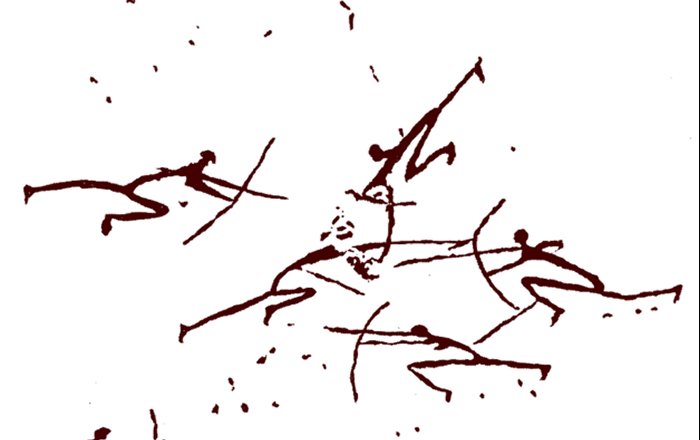Conny Waters – AncientPages.com – A new study shows that social disintegration and violent conflict played a crucial role in shaping the population dynamics of early farming societies in Neolithic Europe.
Cave painting of a battle between archers, Cueva del Roure, Morella la Vella, Castellón, Valencia, Spain. Image credit: Eduardo Hernández Pacheco – public domain
Complexity scientist Peter Turchin and his team at CSH, working as part of an international and interdisciplinary collaboration, may have added a meaningful piece to a long-standing puzzle in archeology. Scholars have long tried to understand why Neolithic farmer populations go through boom-bust cycles, including “collapses” when whole regions are abandoned.
According to one common explanation, climate fluctuations are the main driver, but empirical tests do not fully support this claim. In a new paper, published in the latest issue of Nature Scientific Reports, Turchin and his team seem to have come up with a new piece of information.
“Our study shows that periodic outbreaks of warfare — and not climate fluctuations – can account for the observed boom-bust patterns in the data,” argues Turchin, who’s a project leader at the Complexity Science Hub (CSH).
The team tested the two rival theories attempting to explain these dynamics – climate change and social conflict – in computer simulations and compared the results with historical data.
“This is the first time an agent-based model has been applied to this scale for this period in history, pre-state and pre-empire. The model covers most of the European continent and works with small units, such as independent villages. Previous simulations for this period have been conducted by dividing the area into a few large regions, but we wanted to examine interactions at the village level,” explains CSH scientist Dániel Kondor, who’s the first author of the study.
Change of Heart
Turchin has been applying mathematical models of social integration and disintegration to analyze the rise and fall of complex societies, such as agrarian empires in history or modern nation-states. He admits he wasn’t convinced that such ideas would also apply to prehistory, such as the European Neolithic, where most of the time people lived in small-scale farming communities with no deep social inequalities and limited political organization beyond local settlements.
“I confess that until recently I thought that such societies were quite resilient and not susceptible to social disintegration and collapse,” says Turchin. “There is no state or nobles to rebel against and, in any case, what’s there to ‘collapse’?,” adds the complexity scientist.
Turchin, however, now holds a different view. Increasing evidence suggested that “simple” Neolithic farmers’ societies also collapsed. “In fact, such cases are much more profound than the social and political breakdown of more recent societies, because archaeology indicates that substantial regions were depopulated.”
Computer Simulations
In the study, the researchers focused on the period from the first evidence of agriculture in Europe to the beginning of the Bronze Age – between 7000 BCE and 3000 BCE. The simulation begins with each small unit of the map either empty or occupied by a village of independent farmers. The simulation combines two components: population change in each unit based on climate variability during the time period; and interactions, which include populations in each unit splitting, migrating, or coming into conflict with each other.
The patterns created by the computer simulations were then compared to real-world data. A radiocarbon dating database was used by the team. “Archaeological data on settlements and Carbon-14 dating indicate boom and bust cycles. As settlement data are limited to a few regions and periods, we rely on Carbon-14 data in our model predictions,” explains Kondor.
Based on the study’s findings, climate variation is not capable of explaining boom-bust dynamics during the time period. In contrast, simulations taking into account the social conflict produced patterns similar to those observed in radiocarbon dating.
“Of course, we can’t prove that this is the only mechanism behind the population declines during that time period. There could be other [mechanisms], but we demonstrate that internal conflict producing population cycles is consistent with real-world data,” argues Kondor.
Intense Times
The study presumes a complex social landscape in this time period. Such a notion is consistent with the results of intense archaeological research in Europe over the past century. “This period was indeed much more dynamic than non-specialists might think,” adds Kondor.
“Since we don’t see consistent large-scale political organization during this time, it would be easy to imagine that things were static, such that people settled in a village and lived there for three or four thousand years without much happening in between. That doesn’t seem to be the case. Sadly, this also means that this period was more violent than previously thought.”
“Many case studies have shown that early farming societies underwent socio-political cyclical dynamics from integration to disintegration. These social cycles run more or less parallel to population cycles with outbreaks of considerable violent conflict occurring during the disintegration periods,” explains archaeologist Detlef Gronenborn, from the Leibniz Centre for Archaeology in Mainz, Germany, one of the coauthors of the study.
“With this supra-regional study, we were able to show that the previous can be applied to a much broader region and to a much longer time period. Disintegration and warfare seem to be a general behavioral pattern,” evaluates Gronenborn.
“Additionally, the study indicates that humans and their interactions, whether friendly or violent, form a complex system, regardless of their political or economic organization. It doesn’t matter if you don’t want to organize into a state, you are still affected by your neighbors and their neighbors as well,” adds Kondor.
The study “Explaining population booms and busts in Mid-Holocene Europe,” by Dániel Kondor, James S. Bennett, Detlef Gronenborn, Nicolas Antunes, Daniel Hoyer and Peter Turchin, was published in Nature Scientific Reports 13, 9310 (2023).
Written by Conny Waters – AncientPages.com Staff Writer
